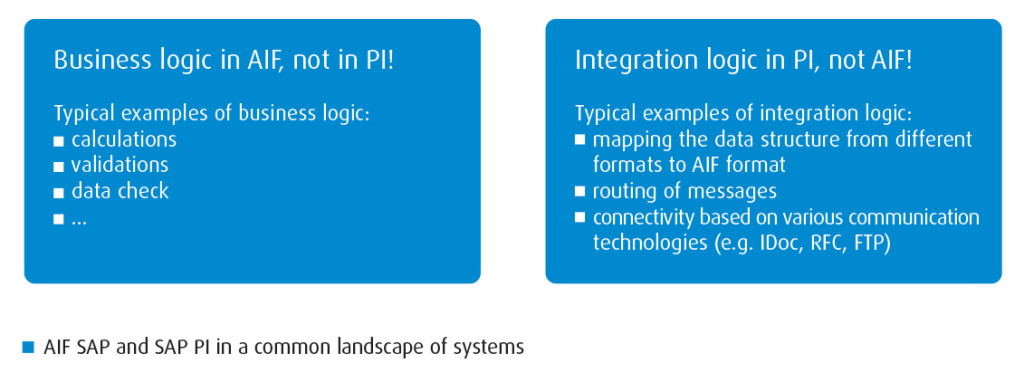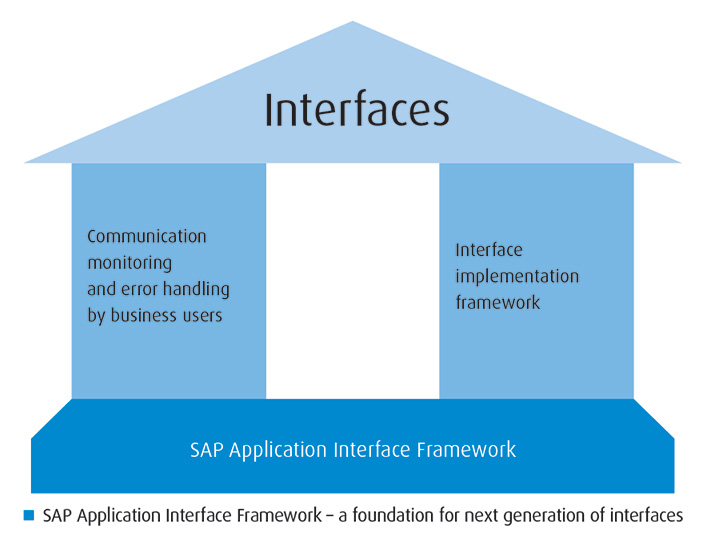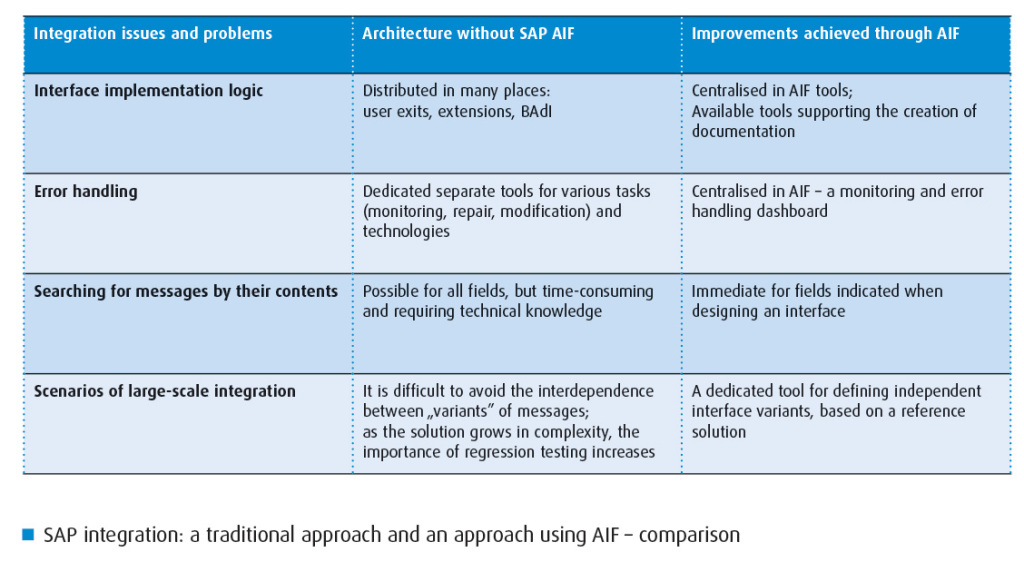Several years ago, the SAP integration toolset was expanded with a new solution. SAP Application Interface Framework (AIF), a new member to the integration family, is an optional add-on to SAP Business Suite systems, for example ERP, CRM or SRM, and is supposed to be an improvement of the so-called “business integration layer", in contrary to SAP Process Integration available so far or SAP Business Connector available previously, responsible for the “technical integration layer".
Intuitively, the technical integration layer includes receiving messages, determining their recipients, mapping and formats adjustment and finally, sending them to the relevant recipients – in short, one could say it means enabling connectivity between the communicating systems. In a sense, it is thus responsible for the overall integration outside the SAP Business Suite.

The business integration layer
At first sight, SAP AIF doesn’t seem to affect the status quo – being based on proven technologies, such as Proxy, IDoc or RFC. However, it introduces a new, standardized handling model for all interface messages in the SAP system and provides a set of tools to allow building typical elements of the integration solution, in many cases – with no need for programming, only using the configuration.
More importantly though, SAP AIF opens the door to the world of integration for business users of the system, providing them with completely new tools for monitoring communication and handling errors if they occur. Along with AIF as the “business integration layer” implementation, SAP has introduced the concept of Forward Error Recovery. “Forward Error Recovery states that »The receiving system must not send an error to the calling system if that error could be handled closer to the receiving system«”; Richard Probst: “SAP Guidelines for Best-Built Applications That Integrate with SAP Business Suite”.
A natural consequence of applying the Forward Error Recovery principle is, therefore, greater involvement of business users in ensuring the correct data exchange between systems. Usually, they are the first people who notice all kinds of irregularities. SAP AIF provides key users (power users) with completely new opportunities.
The devil is in the detail and features like dedicated monitoring and error handling dashboard (centralized in a single tool, and with the possibility to add custom functions), simple messages search by their content, processing details stored in the log (the standard Application Log) and finally, active error notifications and an inbox of notifications (alerts) definitely make the user’s work a lot easier.As proven by the AIF implementations so far, all these elements together help reducing both: the time to handle individual integration errors and the number of the errors in the long run, thus generating significant savings in maintenance costs.

Centralization, standardization, configuration
AIF facilitates the SAP system integration in many ways, on a multidimensional basis. The undoubted benefits come directly from the centralization of the entire interface logic and gathering all the implementation elements in a single place. Until now, individual elements, often implemented incrementally over the years, have been scattered in many small pieces of the code, extensions and user exits. This leads to increasingly complicated tests and anomalies analysis of the solution over time.
In addition to that, AIF standardizes and unifies the approach for processing each individual message, regardless of the technology used to deliver them. In the first processing step, the structure of received data is adjusted to the requirements of the SAP system (Structure Mappings). In addition, a pre-verification of the data received (Checks) and data conversion rules (Value Mappings; Fix Values) can also be defined. After pre-processing, the message is passed to Actions, whose task is to run the appropriate application logic – this may include making a relevant posting, creating a purchase order or changing material master data.
All these elements are then assigned to specific interfaces in a flexible configuration-based manner. In case of more complex components, the developer can involve programming components as well. It is worth noting that AIF naturally supports the reuse of existing elements, while building new interfaces, thereby permanently reducing the costs of developing further integration scenarios.
Variants of interfaces and their documentation
SAP AIF also provides new solutions to common problems of large- or massive-scale integration. Typically, every large enterprise utilizes some data exchange interfaces, that are expected to work “almost in the same way" for different countries or other organizational units within the enterprise. In this case, AIF allows defining so called Interface Variants that enable using an existing solution as reference and on top of that, defining “local" differences a dedicated place. Similar flexibility and independence is proven to be difficult to achieve in the integration model without AIF.
Interestingly, the Application Interface Framework supports, organizes and automates also the process of documenting the solution under construction, since the documentation is entered directly in the system itself and assigned to each configurable component of the integration scenario. Then, a dedicated tool enables you to gather the description of the individual components and to generate the complete documentation of a selected interface from those.
Authorizations and sensitive data
In addition to all the aforementioned features, AIF introduces many improvements in the compliance area. The access to monitoring and individual error handling tools may be limited with authorizations to individual interfaces. Moreover, authorization rules can be defined based on the content of the message, for example, organizational structure elements. Thanks to this, each user has access only to those messages and interfaces, whose handling is really his or her responsibility in the SAP system.
The user can also be authorized to modify the contents of selected fields during error handling. Furthermore, a list of such changes made in the system can be prepared, for instance, for audit purposes. Finally, you can hide the contents of selected fields (ones that contain sensitive data) from the user’s eyes, in the monitoring and error handling tools.
A missing link of integrated systems
SAP AIF can be deployed in parallel with the implementation of a relevant SAP Business Suite system, as well as independently, in a working environment, also for existing interfaces. The solution is ideal to be used both with SAP Process Integration and other technical integration platforms, and – under reasonable circumstances – also as a separate solution. Finally, it may also be used internally inside SAP, to leverage certain system solutions (not necessarily related to interfaces), by means of dedicated APIs.
The Application Interface Framework is, on the one hand, only a slight amendment of the existing functionalities of the SAP system. However, at the same time, it truly revolutionizes the approach to the integration of SAP systems with the “outside world". It organizes the construction and maintenance of interfaces, facilitates their documentation, centralizes and optimizes handling of errors. It is a set of proven solutions and best practices, and provides ready-to-use solutions to many known integration problems using proven technologies, thereby giving the integration with SAP a completely new dimension. At the same time, it is versatile, flexible and independent of the technical integration platform. It supports the integration both within the SAP system and with its environment.
Has the missing link of today’s integrated systems just been created?


